Effects of Variable Diffuser Vanes on Performance of a Centrifugal Compressor with Pressure Ratio of 8.0
Abstract
:1. Introduction
2. Methodology
3. Results and Discussion
3.1. Discussion on Extension of Stable Operating Range
3.2. Discussion on Efficiency Performance
3.3. Discussion on Effects of the Variable Diffuser on the Impeller
4. Conclusions
- A variable vaned diffuser can significantly improve the operating range of centrifugal compressors. The effects of a variable vaned diffuser on high pressure ratio centrifugal compressors are verified. The stable operating range extended at different pressure ratio levels. There is an increase of 30.0% in the operating range of the current case for pressure ratios between 5.0 and 6.0. At higher rotational speeds, the main contributor to range extension is the shifting of the surge line to lower mass flow rates, which is due to the closing of the diffuser. At lower rotational speeds, changing the angle of diffuser vanes has minimal impact on the surge mass flow rate while it significantly shifts the choke line. At medium rotational speeds, both surge and choke lines shift by changing the diffuser vane angle. Thus, both contribute to extending the operating range.
- A variable vaned diffuser has a significant impact on the compressor’s efficiency. At higher rotational speeds, the choke mass flow of the diffuser is matched by that of the impeller. Thus, opening the diffuser at these speed neither shifts the choke line nor improves the efficiency. At lower rotation speeds, however, the impeller and diffuser are not matched and choking happens at the diffuser. Because of this, opening the diffuser extends the operating range by shifting the choke line to higher mass flows and increases the efficiency of the stage by up to 4.5% at 0.8Nmax by improving the matching between impeller and diffuser.
- The impeller performance is independent of the modification in diffuser vane angle. For every rotation speed, the component performance of the impeller is a consistent curve even for diffusers with different vane angles. A change in the diffuser settings did not change the flow conditions at the impeller exit.
- Centrifugal impellers coupled with variable diffusers are able to operate in a wide range of mass flow rates. This is proposed as a general method to study the behavior of the impeller over a wide range of mass flow rates. By applying this approach, a critical point in the operating range of the impeller from stability was found.
- At each rotation speed, there is a certain mass flow rate for the impeller where the incidence angle at the impeller leading edge reaches a critical point. Because of the high incidence angle, instability and separation vortexes will arise in the near-tip region of the impeller as the mass flow rate decreases. This critical point is independent of diffuser settings and stage-wide working conditions such as choke or surge, which means even when the stage is in a stable condition there might be large separation vortexes at the near-tip region of the impeller. The instability in the impeller will grow larger with a further decrease in the mass flow rate.
Acknowledgments
Author Contributions
Conflicts of Interest
Nomenclature
| A | passage area |
| h | enthalpy |
| mass flow rate | |
| choke mass flow rate | |
| surge mass flow rate | |
| Ma | Mach number |
| Nmax | maximum rotational speed of the impeller |
| P | pressure |
| T | temperature |
| r | distance in the radial direction |
| rk | degree of reaction |
| y+ | normalized wall distance |
| Z | number of blades |
| γ | specific heat ratio = 1.4 (constant) for air in this paper |
| η | total-to-total isentropic efficiency |
| π | total-to-total pressure ratio |
| ω | loss coefficient |
Subscripts
| 1 | impeller inlet |
| 2 | impeller exit |
| 3 | rotor-stator interface |
| 4 | diffuser inlet |
| 5 | diffuser outlet |
| 7 | outlet |
| I | impeller |
| D | diffuser |
| S | stage |
| s | static |
| t | total |
References
- Krain, H. Review of Centrifugal Compressor’s Application and Development. J. Turbomach. 2005, 127, 25–34. [Google Scholar] [CrossRef]
- Bents, D.J.; Mockler, T.; Maldonado, J.; Harp, J.L., Jr.; King, J.F.; Schmitz, P.C. Propulsion System for Very High Altitude Subsonic Unmanned Aircraft; NASA Technical Briefs DRC-98-61; NASA Lewis Research Center: Cleveland, UT, USA, 1998.
- Bettner, J.L.; Blandford, C.S.; Rezy, B.J. Propulsion System Assessment for Very High UAV under ERAST; NASA CR-195469; NASA: Cleveland, UT, USA, 1995.
- Rodgers, C. Turbocharging a high altitude UAV C.I. engine. In Proceedings of the 37th Joint Propulsion Conference and Exhibit, Salt Lake City, UT, USA, 8–11 July 2001; American Institute of Aeronautics and Astronautics: Reston, VA, USA, 2001. [Google Scholar]
- Rodgers, C. Flow Ranges of 8.0:1 Pressure Ratio Centrifugal Compressors for Aviation Applications. In Proceedings of the ASME Turbo Expo 2005 Parts A and B, Reno, NV, USA, 6–9 June 2005; Volume 6, pp. 801–811. [Google Scholar]
- Cumpsty, N.A. Compressor Aerodynamics, 2nd ed.; Krieger: Malabar, FL, USA, 2004. [Google Scholar]
- Rodgers, C.; Brown, D. A Performance Autopsy of Three Centrifugal Compressors for a Small Gas Turbine. In Proceedings of the ASME Turbo Expo 2010: Power for Land, Sea, and Air (Volume 5: Industrial and Cogeneration; Microturbines and Small Turbomachinery; Oil and Gas Applications; Wind Turbine Technology), Glasgow, UK, 14–18 June 2010; pp. 239–247. [Google Scholar]
- Zheng, X.; Zhang, Y.; Yang, M.; Bamba, T.; Tamaki, H. Stability Improvement of High-Pressure-Ratio Turbocharger Centrifugal Compressor by Asymmetrical Flow Control—Part II: Nonaxisymmetrical Self-Recirculation Casing Treatment. J. Turbomach. 2012, 135, 21007. [Google Scholar] [CrossRef] [PubMed]
- Li, P.-Y.; Gu, C.-W.; Song, Y. A New Optimization Method for Centrifugal Compressors Based on 1D Calculations and Analyses. Energies 2015, 8, 4317–4334. [Google Scholar] [CrossRef]
- Moosania, S.; Zheng, X. Comparison of Cooling Different Parts in a High Pressure Ratio Centrifugal Compressor. Appl. Sci. 2016, 7, 16–28. [Google Scholar] [CrossRef]
- Whitfield, A. Review of Variable Geometry Techniques Applied to Enhance the Performance of Centrifugal Compressors. In Proceedings of the International Compressor Engineering Conference, West Lafayette, IN, USA, 25–28 July 2000; pp. 63–70. [Google Scholar]
- Simon, H.; Wallmann, T.; Mönk, T. Improvements in Performance Characteristics of Single-Stage and Multistage Centrifugal Compressors by Simultaneous Adjustments of Inlet Guide Vanes and Diffuser Vanes. J. Turbomach. 1987, 109, 41–47. [Google Scholar] [CrossRef]
- Salvage, J.W. Development of a Centrifugal Compressor With a Variable Geometry Split-Ring Pipe Diffuser. J. Turbomach. 1999, 121, 295–304. [Google Scholar] [CrossRef]
- Ziegler, K.U.; Gallus, H.E.; Niehuis, R. A Study on Impeller-Diffuser Interaction—Part I: Influence on the Performance. J. Turbomach. 2003, 125, 173–182. [Google Scholar] [CrossRef]
- Huang, Q.; Zheng, X. Potential of variable diffuser vanes for extending the operating range of compressors and for improving the torque performance of turbocharged engines. Proc. Inst. Mech. Eng. Part D J. Automob. Eng. 2017, 231, 555–566. [Google Scholar] [CrossRef]
- Zheng, X.; Huang, Q. Potential of the range extension of compressors with a variable inlet prewhirl for automotive turbocharged engines with an ultra-high-power density. Proc. Inst. Mech. Eng. Part D J. Automob. Eng. 2015, 229, 1959–1968. [Google Scholar] [CrossRef]
- Zsiga, N.; Voser, C.; Onder, C.; Guzzella, L. Intake Manifold Boosting of Turbocharged Spark-Ignited Engines. Energies 2013, 6, 1746–1763. [Google Scholar] [CrossRef]
- Gwehenberger, T.; Thiele, M.; Seiler, M.; Robinson, D. Single-Stage High-Pressure Turbocharging. In Proceedings of the ASME Turbo Expo 2009: Power for Land, Sea, and Air (Volume 5: Microturbines and Small Turbomachinery; Oil and Gas Applications), Orlando, FL, USA, 8–12 June 2009; pp. 103–113. [Google Scholar]
- Jameson, A. Time Dependent Calculations Using Multigrid, with Applications to Unsteady Flows Past Airfoils and Wings. In Proceedings of the AIAA 10th Computational Fluid Dynamics Conference, Honolulu, HI, USA, 24–26 June 1991; p. 14. [Google Scholar]
- Spalart, P.R.; Allmaras, S.R. A one-equation turbulence model for aerodynamic flows. La Rech. Aerosp. 1994, 1, 5–21. [Google Scholar]
- He, X.; Zheng, X.; Wei, J.; Zeng, H. Investigation of Vaned Diffuser Splitters on the Performance and Flow Control of High Pressure Ratio Centrifugal Compressors. In Proceedings of the ASME Turbo Expo 2016: Turbomachinery Technical Conference and Exposition (Volume 2D: Turbomachinery), Seoul, Korea, 13–17 June 2016; p. V02DT42A008. [Google Scholar]
- Casey, M.; Rusch, D. The Matching of a Vaned Diffuser With a Radial Compressor Impeller and Its Effect on the Stage Performance. J. Turbomach. 2014, 136, 121004. [Google Scholar] [CrossRef]
- Tamaki, H.; Nakao, H.; Saito, M. The Experimental Study of Matching Between Centrifugal Compressor Impeller and Diffuser. J. Turbomach. 1999, 121, 113–118. [Google Scholar] [CrossRef]
- Dixon, S.L.; Hall, C.A. Centrifugal Pumps, Fans, and Compressors. In Fluid Mechanics and Thermodynamics of Turbomachinery; Elsevier: Amsterdam, The Netherlands, 2014; pp. 265–317. [Google Scholar]
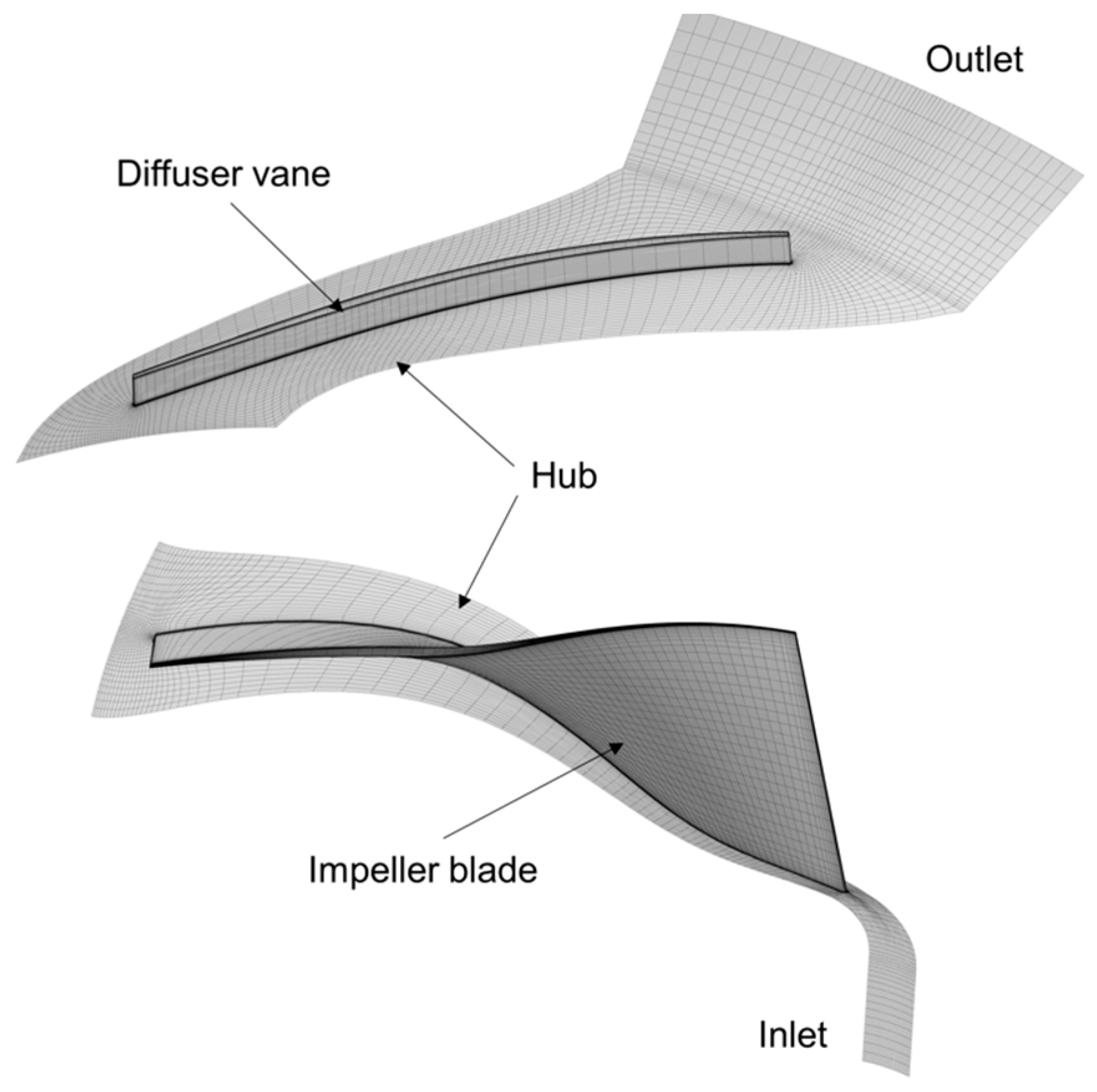
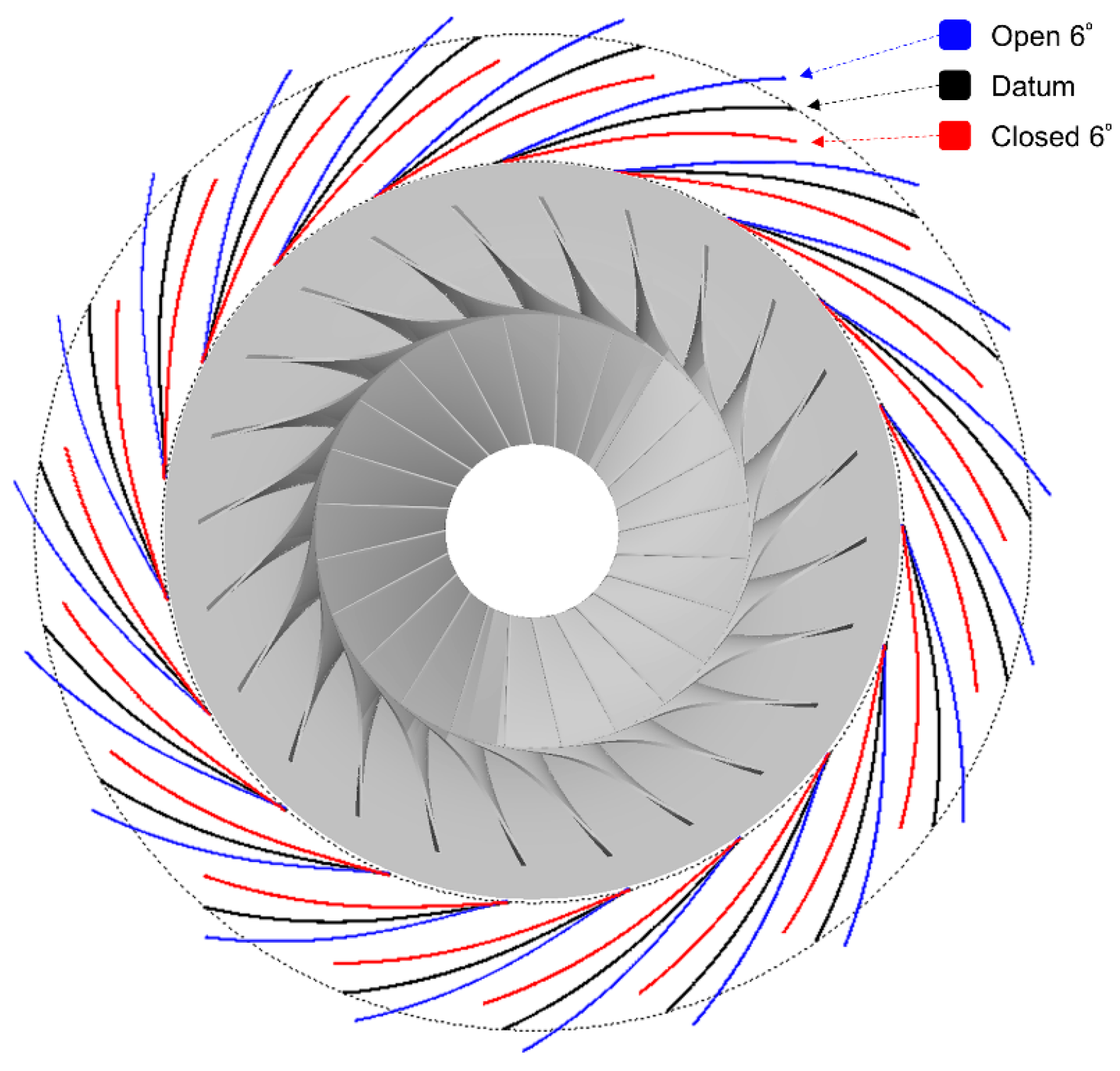
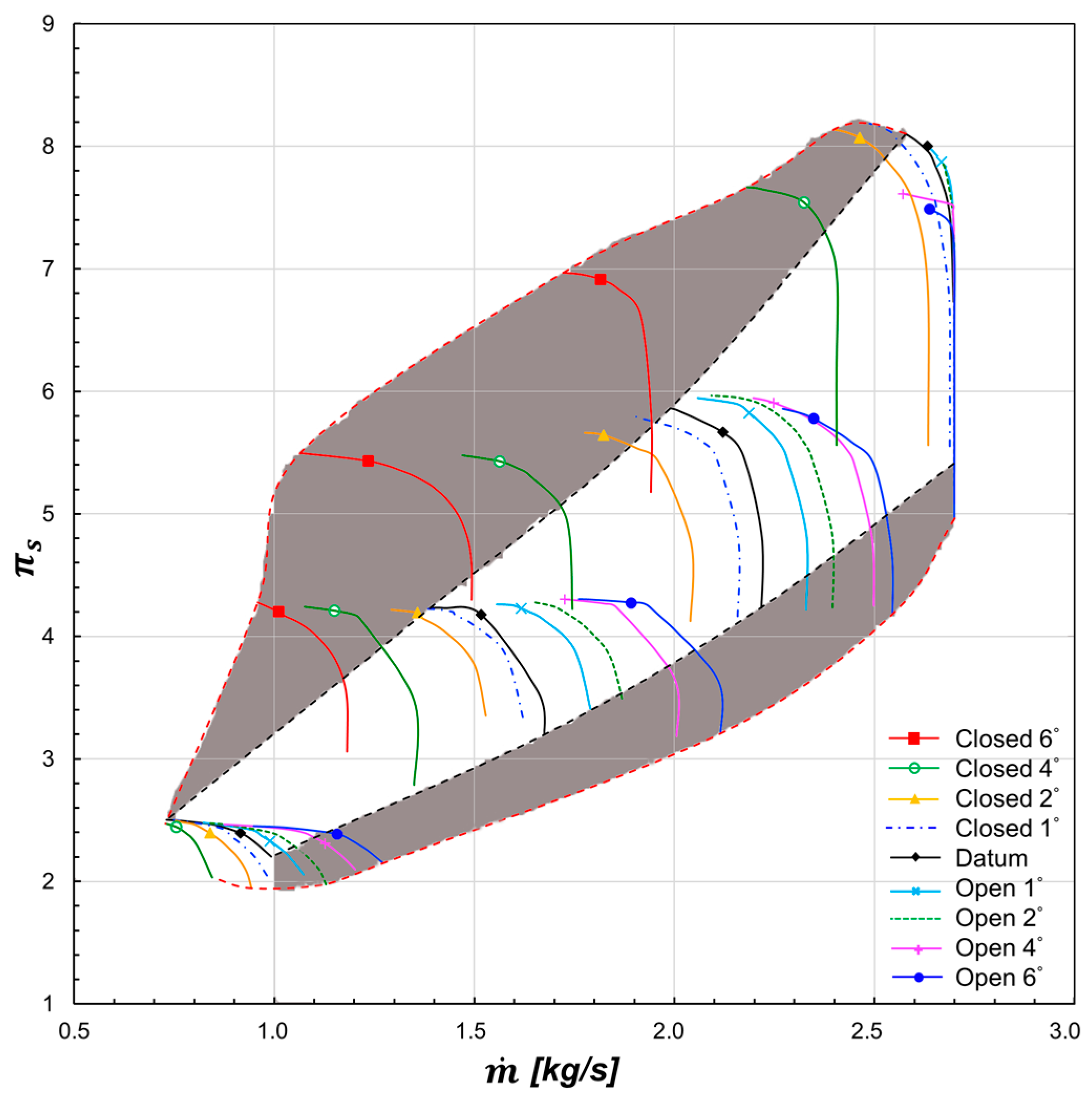


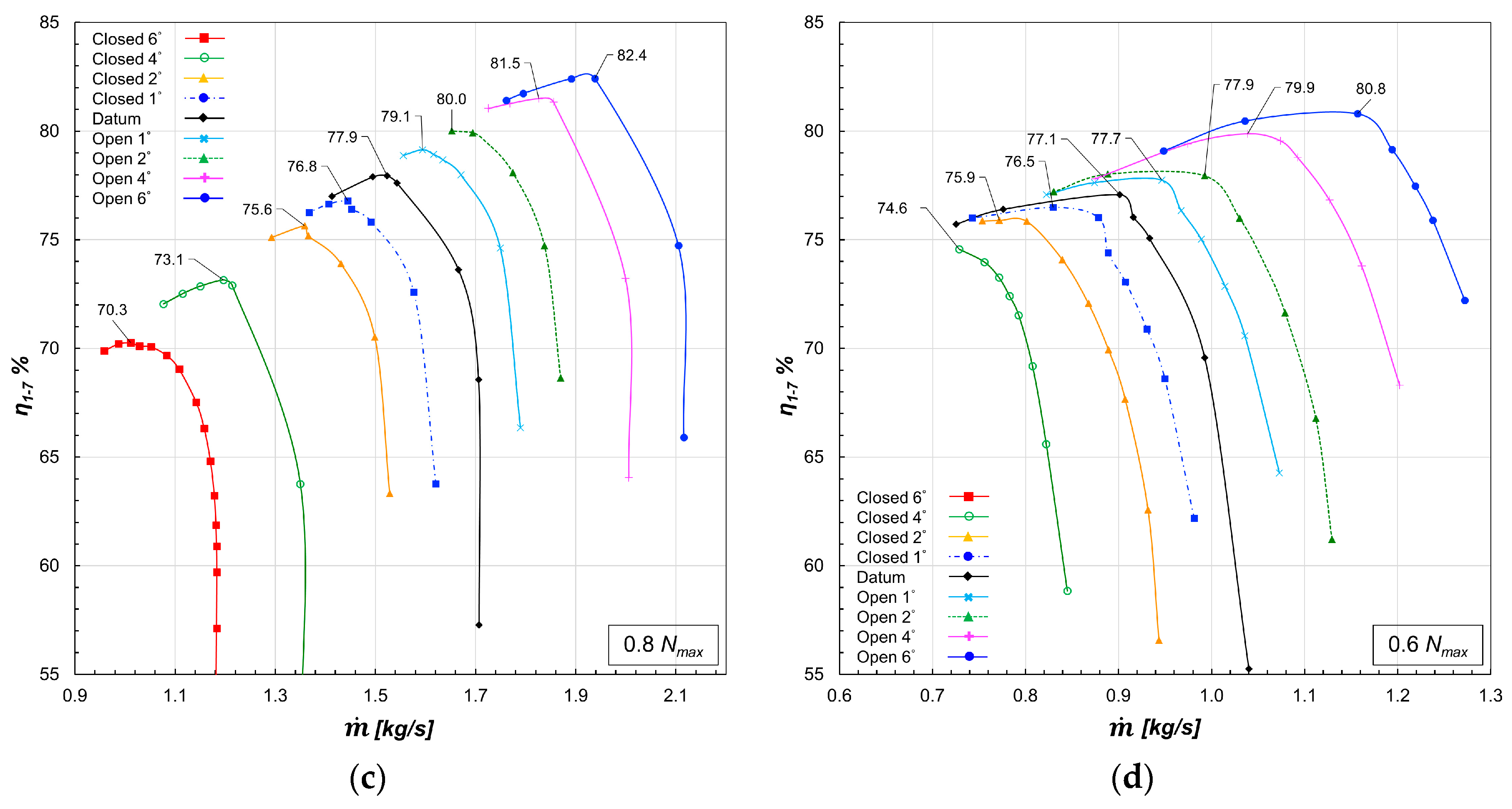



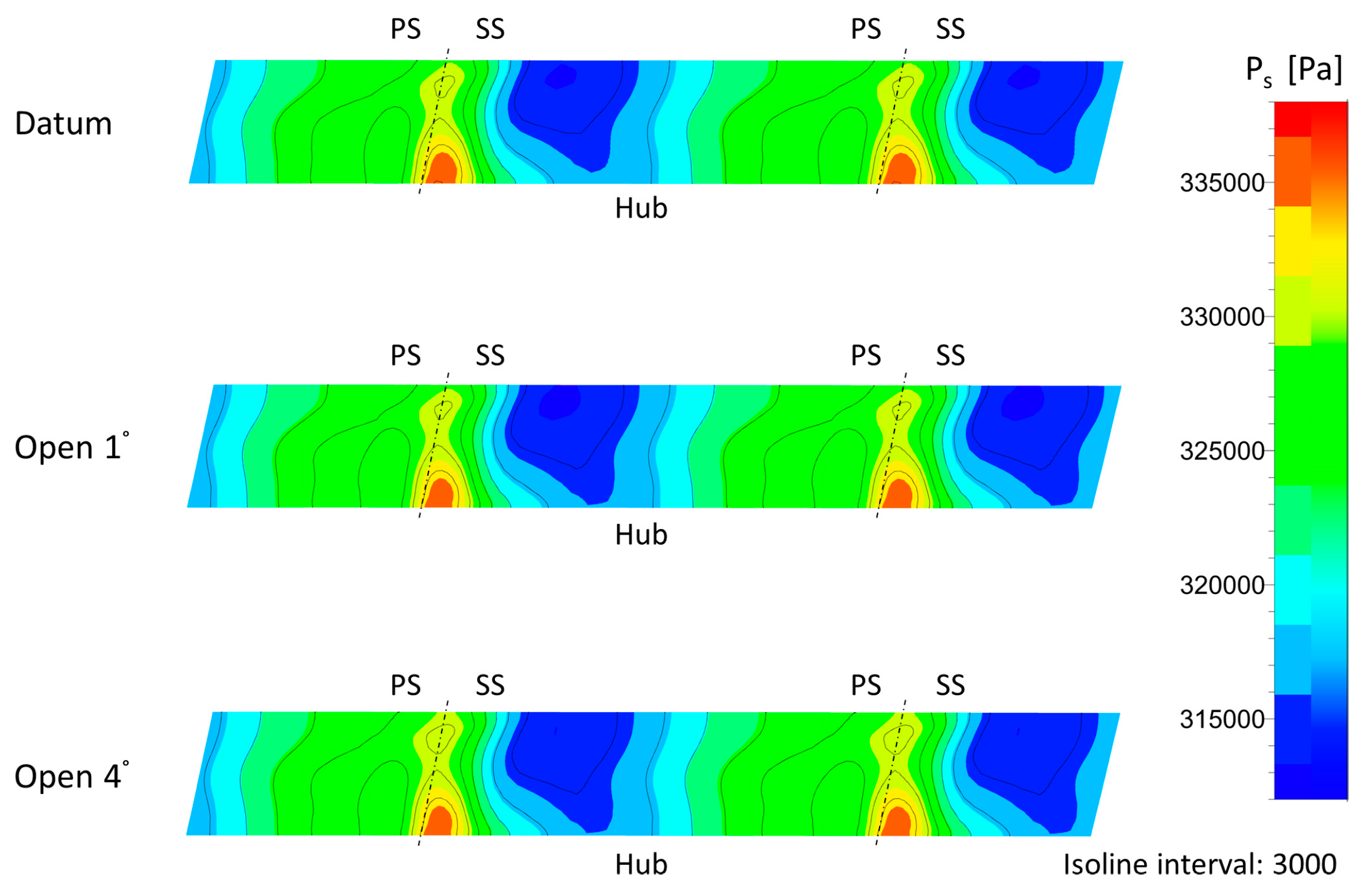

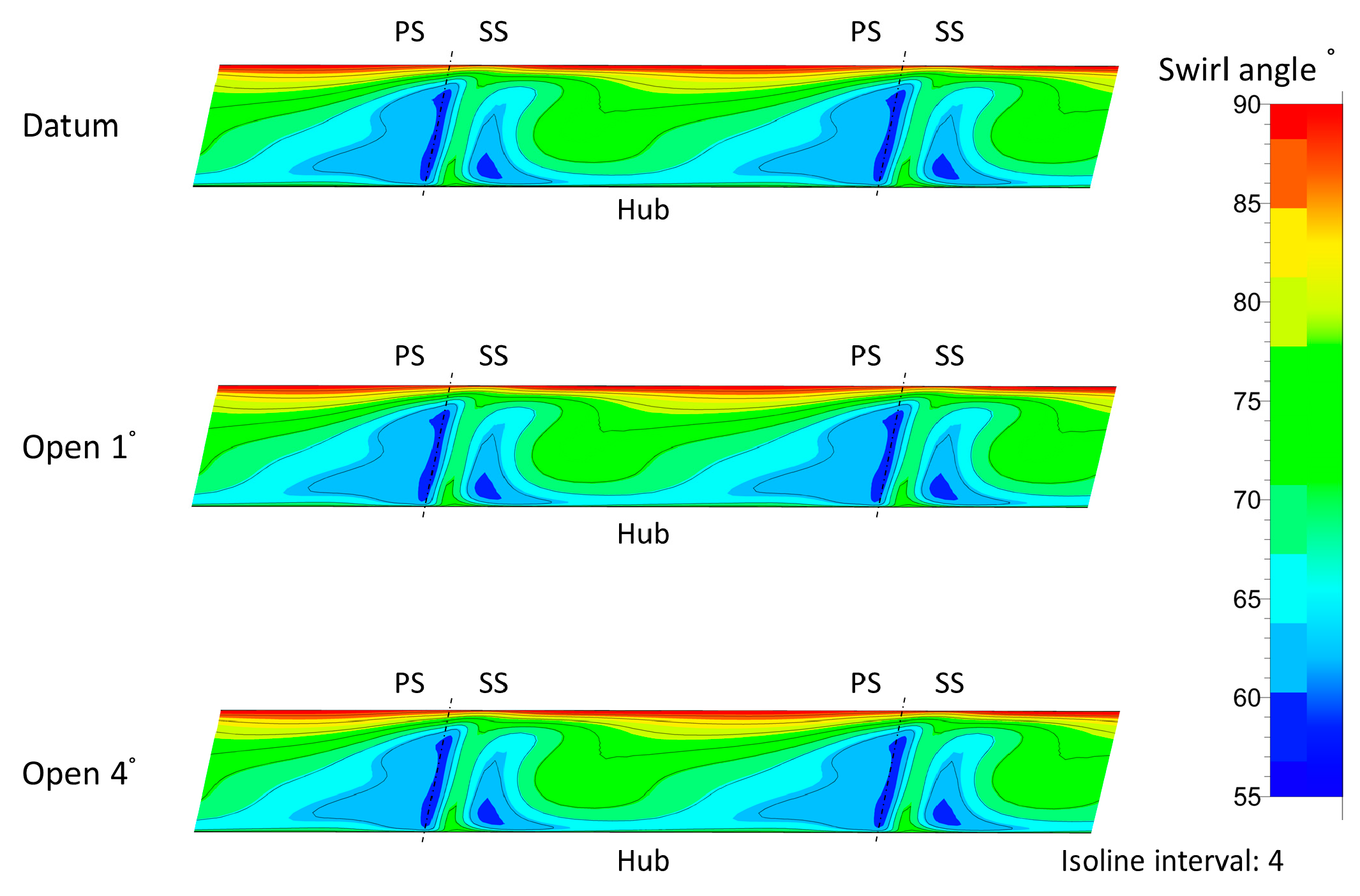

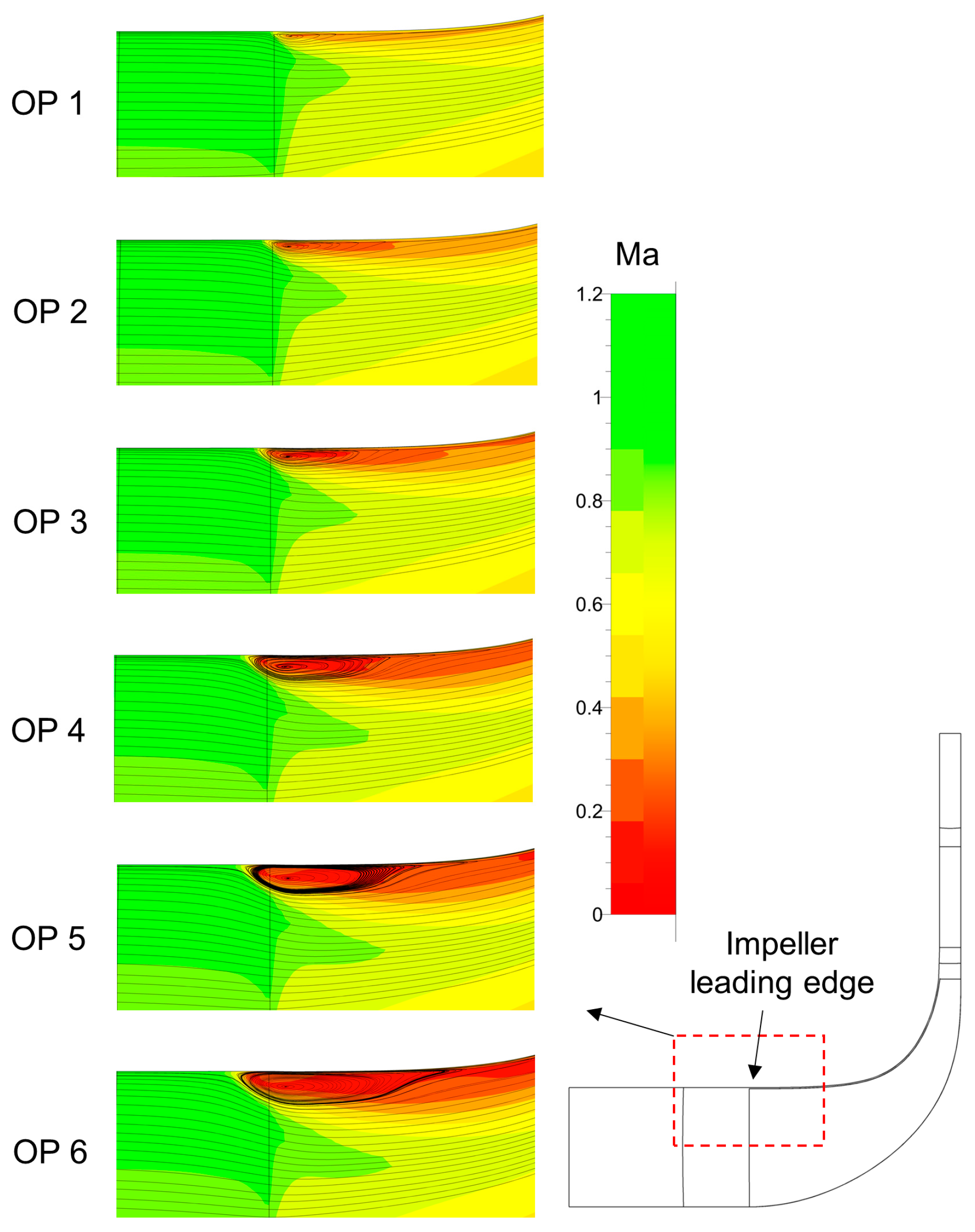
| Impeller | ||
| Number of blades | ZI | 24 |
| Maximum rotational speed | Nmax (r/min) | 52,440 |
| Diffuser | ||
| Number of Vanes | ZD | 19 |
| Area ratio | A5/AThroat | 2.0 |
| Normalized leading edge radius | r4/r2 | 1.10 |
| Normalized trailing edge radius | r5/r2 | 1.48 |
© 2017 by the authors. Licensee MDPI, Basel, Switzerland. This article is an open access article distributed under the terms and conditions of the Creative Commons Attribution (CC BY) license (http://creativecommons.org/licenses/by/4.0/).
Share and Cite
Ebrahimi, M.; Huang, Q.; He, X.; Zheng, X. Effects of Variable Diffuser Vanes on Performance of a Centrifugal Compressor with Pressure Ratio of 8.0. Energies 2017, 10, 682. https://doi.org/10.3390/en10050682
Ebrahimi M, Huang Q, He X, Zheng X. Effects of Variable Diffuser Vanes on Performance of a Centrifugal Compressor with Pressure Ratio of 8.0. Energies. 2017; 10(5):682. https://doi.org/10.3390/en10050682
Chicago/Turabian StyleEbrahimi, Mohsen, Qiangqiang Huang, Xiao He, and Xinqian Zheng. 2017. "Effects of Variable Diffuser Vanes on Performance of a Centrifugal Compressor with Pressure Ratio of 8.0" Energies 10, no. 5: 682. https://doi.org/10.3390/en10050682






